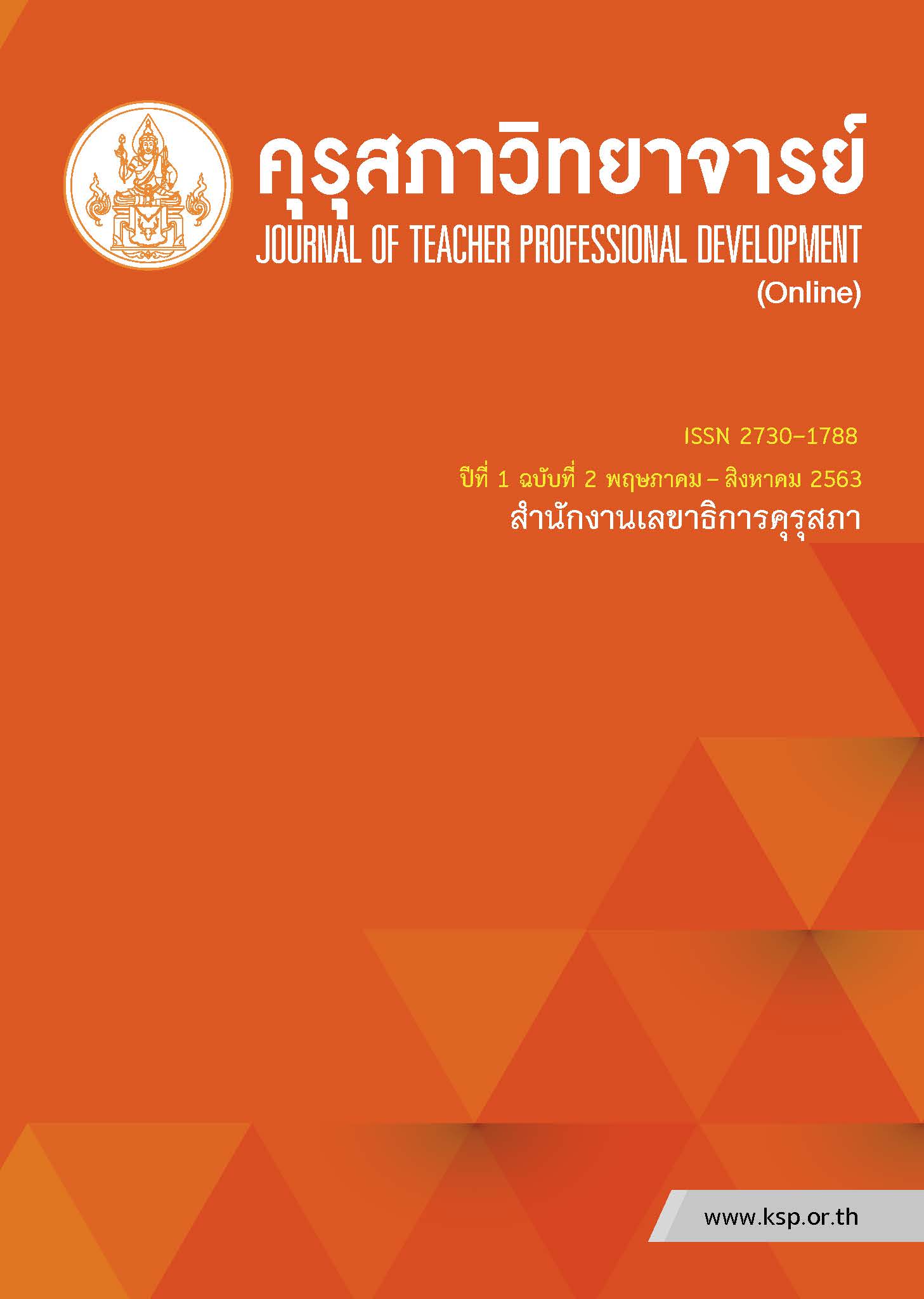รูปแบบการบริหารจัดการโรงเรียนสุขภาวะ: ทุ่งยาวคำโปรยโมเดล
Main Article Content
บทคัดย่อ
การวิจัยนี้มีวัตถุประสงค์หลักเพื่อพัฒนารูปแบบการบริหารจัดการโรงเรียนสุขภาวะ: ทุ่งยาวคำโปรยโมเดลที่มีคุณภาพ มีขั้นตอนดำเนินการวิจัย 3 ระยะ คือ ระยะที่ 1 การพัฒนารูปแบบการบริหารจัดการโรงเรียนสุขภาวะ: ทุ่งยาวคำโปรยโมเดล ระยะที่ 2 การศึกษาผลการใช้รูปแบบการบริหารจัดการโรงเรียนสุขภาวะ: ทุ่งยาวคำโปรยโมเดล และระยะที่ 3 การประเมินรูปแบบการบริหารจัดการโรงเรียนสุขภาวะ: ทุ่งยาวคำโปรยโมเดล กลุ่มผู้ให้ข้อมูล ประกอบด้วย ครู คณะกรรมการสถานศึกษา ผู้ปกครอง นักเรียน ศึกษานิเทศก์ นักวิชาการจากมูลนิธิสถาบันวิจัยระบบการศึกษา และผู้ทรงคุณวุฒิ เครื่องมือที่ใช้ในการรวบรวมข้อมูล ได้แก่ แบบสัมภาษณ์กึ่งโครงสร้าง แบบสังเกตและจดบันทึก แบบประเมินความเป็นประโยชน์ ความเป็นไปได้ ความเหมาะสม และความถูกต้องครอบคลุมของรูปแบบ ข้อมูลเชิงปริมาณวิเคราะห์ด้วยสถิติพื้นฐาน ข้อมูลเชิงคุณภาพใช้การวิเคราะห์เนื้อหา
ผลการวิจัย พบว่า รูปแบบการบริหารจัดการโรงเรียนสุขภาวะ: ทุ่งยาวคำโปรยโมเดลที่พัฒนาขึ้น ประกอบด้วย 4 ขั้นตอน 7 ป.ปัจจัยสู่ความสำเร็จ ดังนี้ 1) ปัจจัยนำเข้า คือ ป.1 เป้าหมายร่วมกัน ป.2 เปิดโอกาส และ ป.7 ปฏิบัติให้เป็นประจำ 2) กระบวนการ คือ ป.3 ปรับวิธีเรียนเปลี่ยนวิธีสอน ป.4 เป็นทีม และ ป.5 ปฏิบัติงานแบบร่วมมือ 3) ผลผลิต คือ ป.6 ปฏิบัติที่มุ่งผลสัมฤทธิ์ และ 4) ข้อมูลย้อนกลับ ผลการใช้รูปแบบ พบว่าสุขภาวะด้านผู้เรียน ด้านโรงเรียน ด้านสภาพแวดล้อม และด้านชุมชน อยู่ในระดับดีเยี่ยม และรูปแบบมีความเป็นไปได้ ความเหมาะสม ความถูกต้องครอบคลุม และความเป็นประโยชน์ อยู่ในระดับมาก ตามลำดับ
Abstract
The main objective of this research was to develop school health management model: Thungyaokhamproy model. The research process had 3 phases: Phase 1 - to develop school health management model: Thungyaokhamproy model, Phase 2 - to study results of school health management model: Thungyaokhamproy model, and Phase 3 - to evaluate the school health management model: Thungyaokhamproy model. Informants consisted of teachers, school boards, parents, students, supervisors, academicians from Institute for Research on Education System Foundation and experts. The instruments used in this study were a semi-structured interview, an observation and record form, and an assessment form of benefit, possibility, suitability, and propriety of the model. Quantitative data and qualitative data were analysed by descriptive statistics and content analysis, respectively.
The results revealed that the developed school health management model: Thungyaokhamproy model comprised 4 processes with 7 points to success factors. They were: 1) input consisted of P.1 - common goal, P.2 - giving an opportunity, and P.7 - practice regularly; 2) Process consisted of P.3 - changing how to study and teach, P.4 - teamwork, and P.5 - practice participation; 3) Output was P.6 - practice to aim on achievement; and 4) Feedback. Study. The results of school health management model: Thungyaokhamproy model found that aspects on Student health, School health, Environment health, Family health, and Community health were at an excellent level. The model was rated rated at a high level on the aspects of possibility, suitability, propriety, and benefit, respectively.
Article Details
เนื้อหาและข้อมูลในบทความที่ลงตีพิมพ์ในวารสารคุรุสภาวิทยาจารย์ ถือเป็นข้อคิดเห็นและความรับผิดชอบของผู้เขียนบทความโดยตรง ซึ่งกองบรรณาธิการคุรุสภาวารสารไม่จาเป็นต้องเห็นด้วย หรือร่วมรับผิดชอบใด ๆ บทความ ข้อมูล เนื้อหา รูปภาพ ฯลฯ ที่ได้รับการตีพิมพ์ในวารสารคุรุสภาวิทยาจารย์ ถือเป็นลิขสิทธิ์ของวารสารคุรุสภาวิทยาจารย์ หากบุคคลหรือหน่วยงานใดต้องการนาทั้งหมดหรือส่วนหนึ่งส่วนใดไปเผยแพร่ต่อหรือเพื่อกระทาการใด ๆ จะต้องได้รับอนุญาตเป็นลายลักอักษรณ์จากวารสารคุรุสภาวิทยาจารย์ก่อนเท่านั้น
เอกสารอ้างอิง
กัมพล เจริญรักษ์. (2559). การสร้างชุมชนการเรียนรู้วิชาชีพเพื่อปฏิรูปโรงเรียน. วารสารวิชาการ, 19(2), 30-45.
พูลสุข หิงคานนท์. (2540). การพัฒนารูปแบบการจัดองค์การของวิทยาลัยพยาบาล สังกัดกระทรวง
สาธารณสุข. (วิทยานิพนธ์ครุศาสตรดุษฎีบัณฑิต). กรุงเทพฯ: จุฬาลงกรณ์มหาวิทยาลัย.
Bardo, W. John and Hartman, John. J. (1982). Urban Sociology: A Systematic Introduction.
U.S.A.: F.E. Peacock Publishers.
Keeves, J. P. (1988). Educational Research, and Methodology, and Measurement. Oxford:
Pergamon Press.
Madaus, G.F., Scriven, M.S., & Stufflebeam, D.L. (1983). Evaluation Models Viewpoints on
Educational and Human Services Evaluation. (8thed). Boston: Khuwer-Nijhoff.


